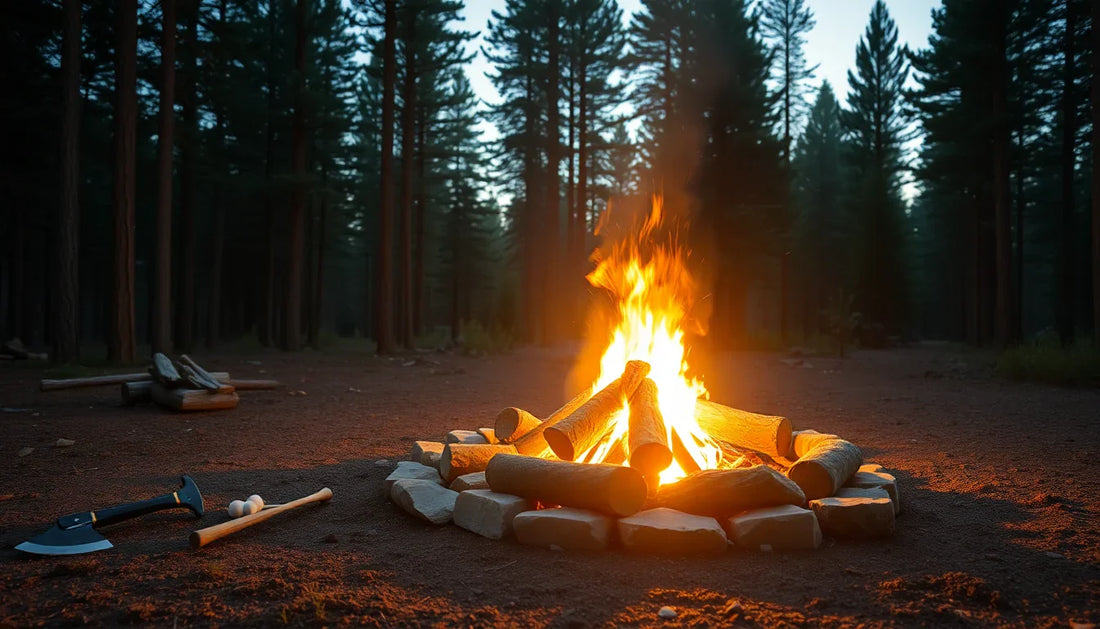
How to Build the Perfect Campfire (and Campfire Safety Rules)
Share
Building the perfect campfire is an essential skill for any outdoor enthusiast. Whether you're camping, hiking, or simply enjoying a backyard bonfire, mastering the art of fire-making can elevate your experience and ensure a safe, enjoyable time in nature. At GlowCamp, we're passionate about equipping adventurers with the knowledge and tools to make the most of their outdoor adventures, and that includes mastering the campfire.
In this comprehensive guide, we'll walk you through the step-by-step process of building the perfect campfire, from selecting the right location to properly extinguishing the flames. We'll also cover crucial campfire safety rules to keep you and your fellow campers safe. By the end of this post, you'll be well on your way to becoming a campfire pro, ready to elevate your outdoor experiences.
Choosing the Right Location
The first and most important step in building a campfire is selecting the appropriate location. Safety should be your top priority when choosing a spot, as an uncontrolled fire can quickly become a dangerous situation.
Safety Considerations
Look for an area that is clear of any overhanging branches, dry leaves, or other flammable materials. Avoid setting up your fire near tents, vehicles, or other structures that could easily catch fire. It's also crucial to check for any fire bans or restrictions in the area, as many parks and campsites have specific rules and regulations regarding open flames.
Proper Ground Selection
The ground itself should be level and free of any debris or vegetation. Ideally, you'll want to build your fire on a surface that is made of mineral soil, gravel, or sand, as these materials are less likely to catch fire. If possible, use a designated fire pit or ring, as these are specifically designed to contain the flames.
Wind and Surroundings Assessment
Take a moment to assess the wind conditions and the overall surroundings. Avoid setting up your fire in an area with strong, gusty winds, as this can cause the flames to spread quickly and unpredictably. Additionally, be mindful of any nearby trees, bushes, or other vegetation that could potentially fuel the fire.
Gathering Materials
Once you've selected the perfect location, it's time to gather the necessary materials for building your campfire. The key to a successful fire lies in having the right mix of firewood, tinder, and kindling.
Types of Firewood
When it comes to firewood, you'll want to use a variety of sizes and types to ensure a long-lasting, efficient fire. Hardwoods like oak, maple, and birch are excellent choices, as they burn hotter and longer than softwoods like pine or fir. Start with larger logs for the base, then add smaller pieces and kindling to help the fire catch and grow.
Tinder and Kindling Selection
Tinder is the material that will help you get the fire started, and it should be dry, easily ignitable, and readily available. Some great tinder options include dry leaves, twigs, paper, or even cotton balls coated in petroleum jelly. Kindling, on the other hand, is the slightly larger material that will help the fire grow and spread. Thin, dry sticks or branches work well for kindling.
Essential Tools for Fire Building
In addition to the fuel, you'll also need a few essential tools to help you build and maintain your campfire. These include matches or a lighter, a fire-starting tool like a ferro rod or flint and steel, and a shovel or rake for managing the fire and extinguishing it when you're done.
Step-by-Step Campfire Building
Now that you've gathered all the necessary materials, it's time to start building your campfire. Follow these steps for a successful, long-lasting fire:
Preparing the Fire Pit
If you're using a designated fire pit or ring, clear away any debris or vegetation from the area. If you're creating a fire pit from scratch, use a shovel to dig a shallow, circular depression in the ground, making sure to remove any flammable materials from the surrounding area.
Arranging Wood and Kindling
Begin by placing the larger logs in a criss-cross pattern at the bottom of the fire pit, creating a sturdy base. Then, add the smaller pieces of kindling on top, arranging them in a way that allows for good airflow. Finally, place the tinder in the center of the kindling, ensuring it's easily accessible for lighting.
Lighting Techniques
When it's time to light the fire, use your matches or lighter to ignite the tinder. Gently blow on the tinder to help the flames catch, and gradually add more kindling as the fire grows. If the fire is struggling to catch, you can try using a fire-starting tool like a ferro rod to generate a spark.
Campfire Safety Rules
Building a campfire is a fun and rewarding experience, but it's crucial to follow proper safety protocols to prevent accidents and protect the environment. Here are some essential campfire safety rules to keep in mind:
Fire Management
Never leave your campfire unattended, and always keep a close eye on the flames. Have a bucket of water or sand nearby to quickly extinguish the fire if necessary. Additionally, be mindful of the size of your fire, and avoid letting it grow too large or out of control.
Monitoring and Maintaining the Fire
Regularly check the fire and add more fuel as needed to keep it burning steadily. Be sure to use the appropriate tools, such as a long stick or poker, to move or rearrange the logs without risking injury.
Proper Extinguishing Methods
When you're ready to call it a night, it's essential to extinguish the fire completely. Douse the flames with water, stirring the ashes to ensure there are no remaining embers. Continue adding water and stirring until the fire is completely out and the ashes are cool to the touch.
Common Mistakes to Avoid
Even experienced campers can make mistakes when it comes to building and maintaining a campfire. Here are some common pitfalls to watch out for:
Fire Building Errors
Avoid building your fire too large or too close to flammable materials. Additionally, be sure to use the appropriate types of firewood and kindling to ensure a clean, efficient burn.
Safety Precautions
Never leave a fire unattended, and always have the proper tools and extinguishing methods on hand. Additionally, be mindful of the weather conditions and wind patterns, as these can significantly impact the behavior of your fire.
Environmental Considerations
Be respectful of the natural environment and follow all local regulations and guidelines regarding open fires. Avoid building fires in areas with dry or sensitive vegetation, and always fully extinguish the fire before leaving the area.
Conclusion
Building the perfect campfire is a skill that takes practice, but with the right knowledge and safety precautions, it can be a truly rewarding experience. By following the steps outlined in this guide and adhering to the essential campfire safety rules, you'll be well on your way to becoming a confident and responsible fire-builder, ready to elevate your outdoor adventures.
At GlowCamp, we believe that mastering the art of the campfire is just one of the many ways to make the most of your time in nature. Whether you're an experienced camper or a newcomer to the great outdoors, we're here to provide you with the gear, knowledge, and inspiration to create unforgettable experiences. So, grab your matches, gather your firewood, and get ready to enjoy the warm glow of a perfectly built campfire.
